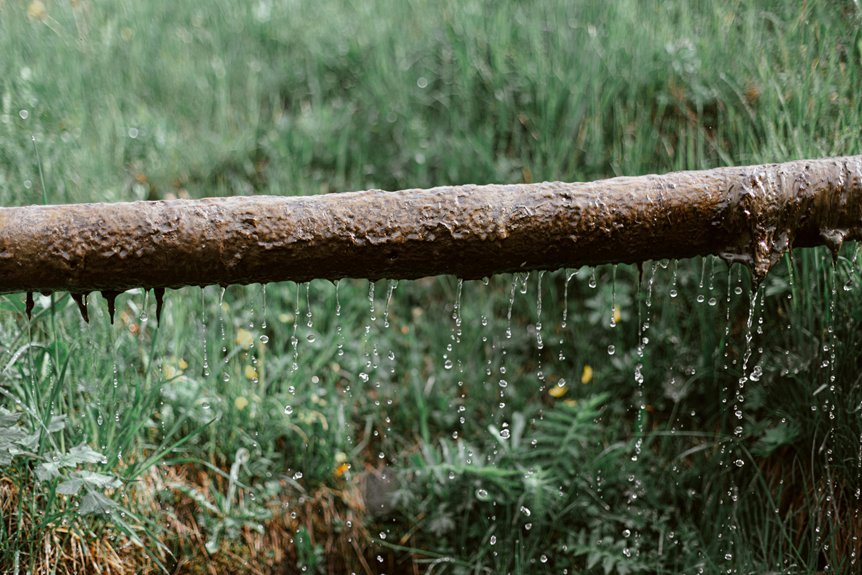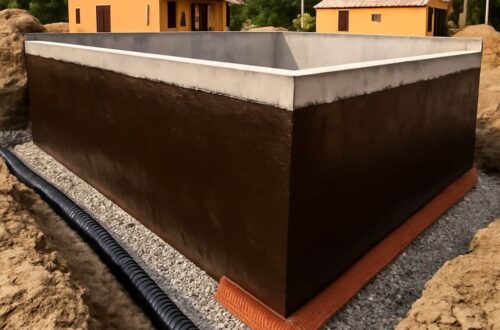Keeping your basement dry without a sump pump is entirely possible with the right strategies. Start by evaluating your basement’s vulnerabilities, as understanding where moisture enters is essential. Improving exterior drainage, maintaining your gutters, and sealing cracks are just a few steps to take into account. You’ll also want to reflect on ventilation and humidity control. Each of these aspects plays a significant role in preventing water damage, and there are effective solutions you can implement.
Key Takeaways
- Regularly inspect and seal cracks in the foundation to prevent water seepage.
- Maintain proper exterior drainage by grading soil away from the foundation and keeping gutters clear.
- Utilize dehumidifiers and enhance ventilation to manage humidity levels in the basement.
- Implement proactive landscaping strategies, such as drainage plants and permeable pavers, to absorb excess moisture.
- Conduct routine visual inspections for vulnerabilities and adjust grading as needed to keep water away from the home.
Assessing Your Basement’s Vulnerability
When it comes to keeping your basement dry, evaluating its vulnerability is essential.
Start by conducting regular basement inspections to identify potential weak spots. Look for cracks in walls or floors where water could seep in. Pay attention to nearby water sources, such as downspouts or gutters, which can contribute to moisture issues.
If your home’s grading slopes toward the foundation, this increases the risk of water intrusion. By pinpointing these vulnerabilities, you can take proactive measures to mitigate risks and maintain a dry basement.
Improving Exterior Drainage
To keep your basement dry, it’s essential to improve your home’s exterior drainage.
Start by grading the soil away from your foundation, which will help direct water away.
Don’t forget to maintain your gutters and consider using downspout extensions to further prevent water from pooling around your home.
Grading Soil Away
One of the most effective ways to prevent water from pooling around your basement is by properly grading the soil around your home. Aim for a slope of at least 6 inches over the first 10 feet. This enhances drainage solutions and reduces the risk of water seeping into your basement. Verify soil compaction is adequate; loose soil can lead to erosion and ineffective drainage.
| Action | Benefit |
|---|---|
| Grade soil away | Directs water away |
| Compact soil | Reduces erosion risk |
| Maintain slope | Keeps basement dry |
Gutter Maintenance Tips
Properly grading the soil around your home is just the beginning of effective water management for your basement.
Regular gutter maintenance is vital. Start by identifying your gutter types—whether they’re K-style, half-round, or box gutters—and verify they’re suitable for your home.
Schedule seasonal cleaning, ideally in spring and fall, to remove leaves, debris, and dirt that can cause clogs. Clear downspouts and check for any damage or rust, as well.
This simple upkeep prevents overflow, directing water away from your foundation and keeping your basement dry.
Don’t overlook this essential aspect of home maintenance!
Downspout Extensions Usage
Installing downspout extensions can greatly enhance your home’s exterior drainage system. These extensions direct rainwater away from your foundation, reducing the risk of basement flooding.
Guarantee proper downspout placement by positioning extensions at least three to four feet from your home. Choose durable downspout materials like PVC or aluminum to withstand the elements and prevent wear over time.
Regularly check for clogs and guarantee that extensions remain securely connected. By managing water runoff effectively, you’ll protect your home’s structural integrity and maintain a dry basement, providing peace of mind during heavy rainstorms.
Installing Gutter Systems
When rainwater flows off your roof without a proper gutter system, it can lead to significant moisture issues in your basement. To prevent this, consider installing gutters that suit your home’s needs.
There are various gutter types, including K-style and half-round, each offering unique benefits. For effective gutter installation, start by measuring your roofline and purchasing the appropriate materials.
Make certain your gutters are sloped toward downspouts for ideal drainage. Regularly clean out debris to maintain efficiency.
Sealing Cracks and Gaps
To keep your basement dry, sealing cracks and gaps in your foundation is essential. Water can seep through these openings, leading to moisture issues.
Here’s how to tackle this:
- Inspect your foundation regularly for visible cracks and gaps.
- Clean the areas around the cracks to remove dirt and debris.
- Apply crack sealing products specifically designed for concrete to fill in cracks.
- Use gap filling foam or caulk to seal larger gaps, ensuring a tight fit.
Utilizing Dehumidifiers
Utilizing dehumidifiers can greatly enhance your efforts to keep a basement dry, especially in humid climates. With the right dehumidifier settings, you can markedly improve moisture absorption and create a more comfortable environment. Choose a unit based on your basement’s square footage and humidity levels.
| Dehumidifier Size | Ideal Room Size (sq ft) |
|---|---|
| 30 Pints | Up to 1,500 |
| 50 Pints | Up to 2,500 |
| 70 Pints | Up to 3,500 |
| 100 Pints | Up to 4,500 |
Regularly empty the water tank or utilize a drain hose for continuous operation.
Ventilating Your Basement
Effective ventilation is crucial for maintaining a dry basement, as it helps to reduce humidity levels and prevent mold growth.
To improve air circulation in your basement, consider these strategies:
- Open Basement Windows: Allow fresh air to flow in and stale air to escape.
- Install Ventilation Fans: Use fans to enhance air movement, especially in damp areas.
- Use a Dehumidifier: Pair with ventilation to control moisture effectively.
- Check Ductwork: Verify any HVAC systems are functioning properly to support airflow.
Landscaping for Drainage
While you mightn’t think of landscaping as a means to keep your basement dry, the way you design your yard can greatly impact drainage.
Start by incorporating drainage plants, which absorb excess water and help manage moisture levels in your yard. Opt for permeable pavers instead of solid concrete for your patios and walkways; they allow rainwater to seep into the ground, reducing runoff.
Create gentle slopes away from your foundation to direct water away from your home. By thoughtfully planning your landscape, you can enhance drainage and protect your basement from unwanted moisture.
Using Moisture-Resistant Materials
To keep your basement dry, choosing moisture-resistant materials is essential for construction and renovation projects.
By selecting the right materials, you can greatly reduce moisture accumulation.
Consider these options:
- Moisture resistant insulation: Use closed-cell spray foam or rigid foam boards to insulate walls effectively.
- Waterproof wall coatings: Apply a waterproof sealant to interior walls to prevent moisture from seeping through.
- Vinyl flooring: Opt for vinyl or tile flooring, which can withstand damp conditions better than wood or carpet.
- Cement board: Install cement board in wet areas, as it resists mold and moisture damage.
These choices will help maintain a dry basement.
Regular Maintenance and Inspections
To keep your basement dry, regular maintenance and inspections are essential.
Start by checking your gutters and downspouts for clogs, looking for cracks in your foundation, and ensuring your landscaping directs water away from your home.
Staying proactive with these tasks can prevent water damage and costly repairs down the line.
Inspect Gutters and Downspouts
Regularly inspecting your gutters and downspouts is essential for keeping your basement dry. Neglecting this task can lead to water pooling around your foundation.
Here’s how to effectively maintain them:
- Gutter Cleaning: Remove leaves and debris at least twice a year to guarantee proper flow.
- Downspout Inspection: Check for clogs or damage that can redirect water toward your home.
- Extension Installation: Confirm downspouts are extended at least 4-6 feet from the foundation.
- Slope Check: Verify that gutters are sloped properly to encourage drainage away from the house.
Stay proactive to prevent water issues!
Check for Cracks
Cracks in your basement walls or floor can lead to significant water intrusion, so it’s essential to check for them regularly.
Start with visual inspections; look for gaps or uneven surfaces. Use crack detection methods, like a moisture meter, to identify hidden issues.
If you find cracks, assess their size and depth—small hairline fractures may not require immediate action, but larger cracks could indicate a need for foundation repair.
Don’t hesitate to consult a professional if you’re unsure about the severity. Keeping your basement dry starts with proactive crack detection and timely repairs.
Maintain Landscaping Grading
While you may not think about it often, maintaining proper landscaping grading is essential for keeping your basement dry. Effective landscape design can direct water away from your home, reducing moisture issues.
Here are some key steps for regular maintenance and inspections:
- Inspect grading: Confirm the ground slopes away from your foundation.
- Clear debris: Remove leaves and dirt from gutters and drainage systems.
- Adjust soil: Add soil if the grading has settled or eroded.
- Evaluate drainage solutions: Consider installing drains or swales if water pooling occurs.
Conclusion
By taking proactive steps to improve drainage, seal cracks, and maintain humidity levels, you can effectively keep your basement dry without relying on a sump pump. Regular inspections and adjustments to your landscaping will further enhance your efforts. Don’t forget to utilize dehumidifiers and guarantee proper ventilation for ideal air quality. With consistent attention and care, you can create a dry, comfortable basement space that protects your home and belongings for years to come.






